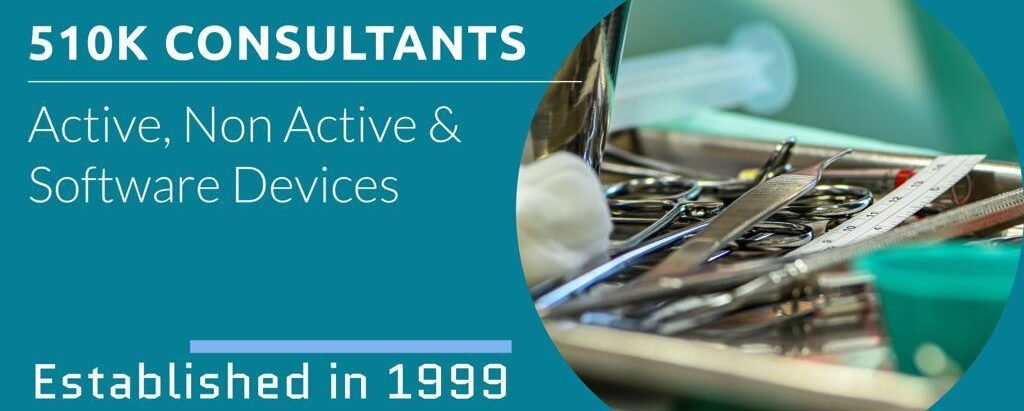Difference Between 510k and CE submission
The most popular regulatory route for marketing a medical device in the US is a 510(k). For a device of the same level of risk, a CE Mark is required to market a medical device in the European Economic Area. CE marking means Conformité Européenne or European conformity in French. And as the name suggests, it proves product compliance with European requirements that ensure specific safety, health, and environmental protection standards.
It can be required for several different products. Regarding medical devices, the CE marking allows companies to move and sell their devices across the 30 countries of the European Economic Area (EEA) once they follow the EU Regulation 2017/746, also known as the Medical Device Regulation (MDR)
A 510(k) is a premarket submission made to the FDA. It is called a 510(k) because it refers to that section of the Food, Drug, and Cosmetic Act. It is the regulatory pathway mostly utilized for Class II devices that hope to be substantially equivalent to another device that is currently legally marketed. If the FDA agrees that the device is substantially equivalent, it may be marketed immediately without needing a premarket approval (PMA) submission.
If you’re a manufacturer or specification developer seeking approval for a new medical device, you’ll need to submit a 510k application to the FDA.
We specialize in assisting medical device manufacturers and specification developers in efficiently preparing and submitting their 510k files to the FDA, reducing the likelihood of receiving an initial “Refuse to Accept” (RTA)
Steps in 510k and CE marking process.
| Steps in 510k Clearance | Steps in CE marking |
| · Determine the product code and class of the proposed medical device to confirm whether the device falls under the 510k pathway.
· Select an appropriate predicate device with the same intended use using the 510k database. · Find applicable FDA guidance documents and consensus standards from FDA websites. · Complete all the necessary performance testing, perform clinical studies (if required) and biological evaluation, and collect the reports. · 20 sections of the 510(k) documentations should be completed · 510(k) file must be reviewed using the Refuse to Accept (RTA) checklist to ensure that you’re following the FDA guidelines for completeness. · Pay the review fee and submit an e-copy to the FDA( Companies outside US must submit through a US agent) · FDA conducts, acceptance review, substantive review and Interactive review · If the device gets 510k cleared submitter gets email decision letter from FDA · The 510K cleared devices can be found in the FDA database and may be legally marketed in the US. · Establishment registration and Device listing must be completed.
|
· Determine whether your product meets the definition of a medical device according to the MDR.
· Determine the classification of your device. See our chart. · Implement a Quality Management System, if applicable to your device. Most companies use ISO 13485 to meet the requirements. · Register the Device Under a Unique Device Identifier · Prepare a CE Marking Technical Documentation · Conduct Risk management activities according to ISO 14971 · Prepare a Clinical Evaluation Report (CER) according to MEDDEV 2.7/1 rev4 and MDR. · Select and appoint a European Authorized Representative (EC REP) to act on your behalf within the EU if you have no physical location in Europe. · Have the QMS and Technical Documentation audited by a Notified Body, unless your device is Class I, is not sterile, and has no measuring function. · Obtain CE Marking and ISO 13485 certificates from your Notified Body. · Prepare a Declaration of Conformity (DoC) stating that your device complies with the MDR. · Affix a CE Marking to the Medical Device · Maintain a Post-Market Surveillance
|
Do you need an email containing full details about 510k within 2 minutes?
Validity of CE Certificate and 510k Clearance
CE Certificate to be re-certificated evrey 3 years. For instance, a class IIa device can receive a certificate valid for just three years. Moreover, annual surveillance audits are conducted between certifications
510(k) clearance will not expire and is valid until changes are made to the intended use, the indications for use are altered, or technological characteristics are changed
Working with CE Marking consultants like I3CGLOBAL helps manufacturers prepare and respond to Notified Bodies review queries more efficiently and effectively, ultimately speeding up the CE Mark approval process.
Frequently Asked Questions
Is Substantial Equivalence mandatory for CE Marking?
CE Marking Substantial Equivalence is NOT Aplicable
Is Clinical Evaluation Report mandatory for FDA 510K?
- 100% of medical devices with CE Marking require a clinical evaluation report (CER) as an essential requirement in the technical file
- 10-15% of 510k submissions require clinical studies
Is PMCF (Post-Market Clinical Follow-up applicable for both?
- 100% recommended only for most devices in CE Marking
- recommended only for high-risk devices in 510k submissions
Is QMS applicable for both?
- Must finish QMS before CE Mark submission
- Not mandatory during submission 510k submissions
Is Risk Management applicable for both?
- Recommended for moderate to high-risk devices only in 510k
- Mandatory for all devices IN CE Marking

